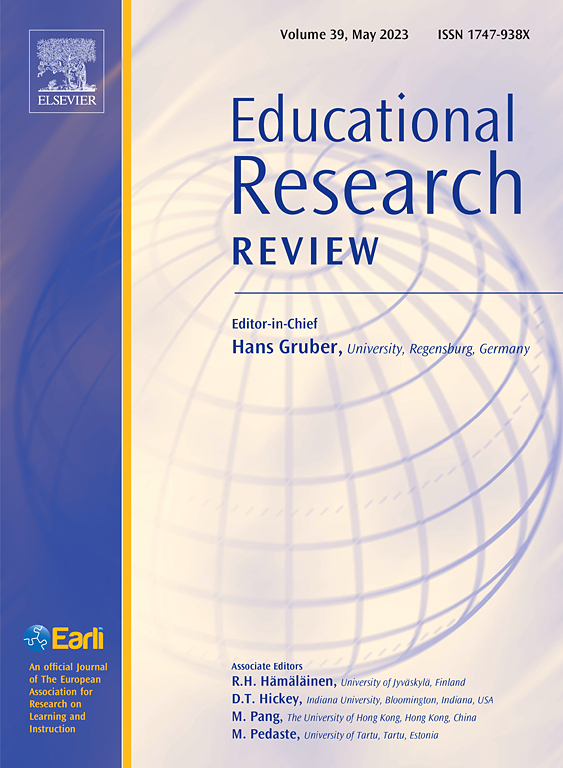The relationship between media literacy and well-being: A systematic review and meta-analysis
IF 10.6
1区 教育学
Q1 EDUCATION & EDUCATIONAL RESEARCH
引用次数: 0
Abstract
Media literacy and well-being are interconnected topics that have garnered increasing attention in recent years due to the proliferation of media platforms and the influence they can exert on individuals' mental health and overall well-being. Media literacy is a lifelong educational process, defined as the ability to critically access, analyse, evaluate, create, and contribute to media. It is especially important for children and adolescents who are more susceptible to negative media influences. Well-being encompasses both feeling good and functioning effectively, and is associated with numerous benefits including increased productivity and creativity, and better relationships, health and life expectancy. Guided by the 2020 Preferred Reporting Items for Systematic Review and Meta-Analysis (PRISMA) statement, this systematic review and meta-analysis examined the associations between media literacy and well-being. The search identified 15 studies involving 47 effect sizes across a variety of dimensions of media literacy. Together, the studies had 16,632 participants and 51.8 % comprised school-aged populations. The analysis initially revealed a statistically significant, small to medium, positive association between media literacy and well-being (r = .19, 95 % CI [.01, .35]); however, this association was no longer significant following sensitivity analyses. The ‘Media Literacy Dimension’ significantly moderated the pooled effect. A medium-sized positive association between media literacy and well-being was observed when the media literacy measure was solely focussed on analysing/evaluating the media (r = .24, 95 % CI [.05, .41]). No other significant moderating factors were found. However, due to limitations such as small sample size and significant heterogeneity among the studies, these findings should be interpreted with caution, especially when considering implications for educational policy or curriculum integration. Further research, especially using longitudinal and experimental designs, is needed to better understand the nature and direction of this relationship and to inform practical applications.
媒介素养与幸福感的关系:系统回顾与元分析
媒体素养和福祉是相互关联的主题,近年来由于媒体平台的激增及其对个人心理健康和整体福祉的影响而引起了越来越多的关注。媒介素养是一个终身的教育过程,定义为批判性地获取、分析、评估、创造和贡献媒体的能力。这对更容易受到媒体负面影响的儿童和青少年尤其重要。幸福包括感觉良好和有效运作,并与许多好处相关,包括提高生产力和创造力,更好的人际关系,健康和预期寿命。在2020年系统回顾和荟萃分析首选报告项目(PRISMA)声明的指导下,本系统回顾和荟萃分析研究了媒体素养与幸福感之间的关系。这项研究确定了15项研究,涉及47个效应值,涉及媒体素养的各个维度。这些研究共有16,632名参与者,其中51.8%是学龄人口。分析最初显示,媒体素养与幸福感之间存在统计学上显著的、小到中等的正相关(r = 0.19, 95% CI)。01, .35点);然而,在进行敏感性分析后,这种关联不再显著。“媒介素养维度”显著调节了聚合效应。当媒体素养测量仅专注于分析/评估媒体时,观察到媒体素养与幸福感之间存在中等正相关(r = 0.24, 95% CI)。05年,.41点)。未发现其他显著的调节因素。然而,由于样本量小和研究之间存在显著的异质性等局限性,这些研究结果应谨慎解释,特别是在考虑对教育政策或课程整合的影响时。需要进一步的研究,特别是使用纵向和实验设计,以更好地了解这种关系的性质和方向,并为实际应用提供信息。
本文章由计算机程序翻译,如有差异,请以英文原文为准。
求助全文
约1分钟内获得全文
求助全文
来源期刊

Educational Research Review
EDUCATION & EDUCATIONAL RESEARCH-
CiteScore
19.40
自引率
0.90%
发文量
53
审稿时长
57 days
期刊介绍:
Educational Research Review is an international journal catering to researchers and diverse agencies keen on reviewing studies and theoretical papers in education at any level. The journal welcomes high-quality articles that address educational research problems through a review approach, encompassing thematic or methodological reviews and meta-analyses. With an inclusive scope, the journal does not limit itself to any specific age range and invites articles across various settings where learning and education take place, such as schools, corporate training, and both formal and informal educational environments.
 求助内容:
求助内容: 应助结果提醒方式:
应助结果提醒方式:


